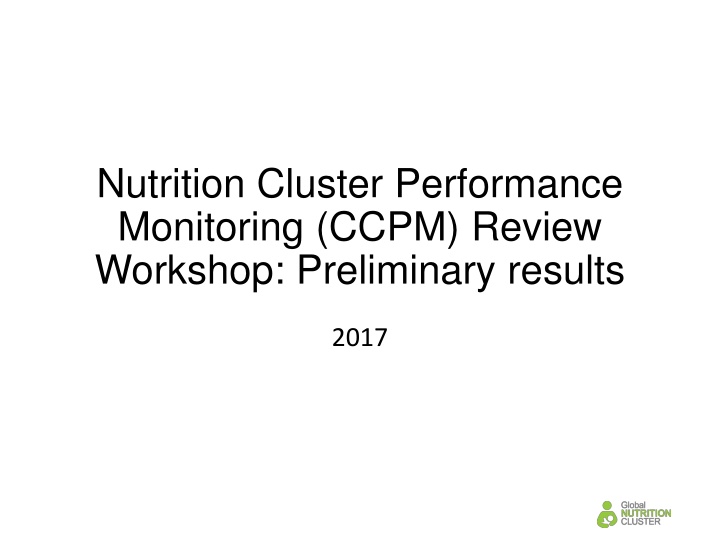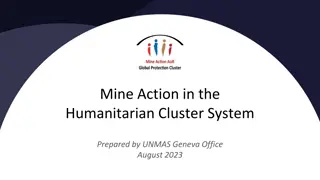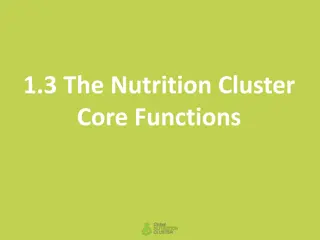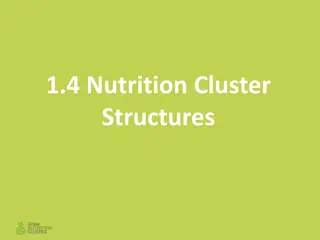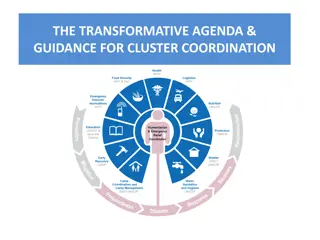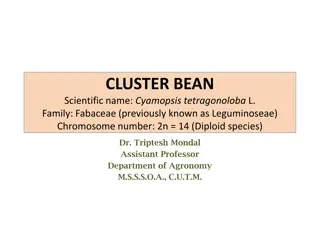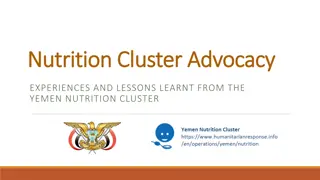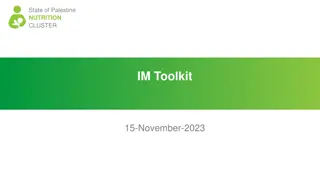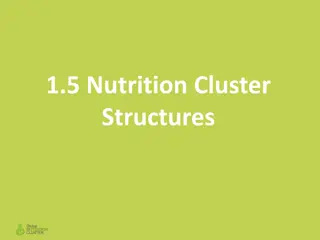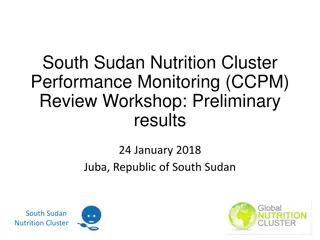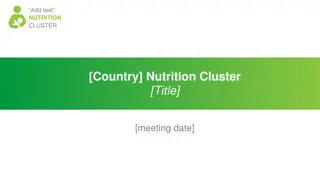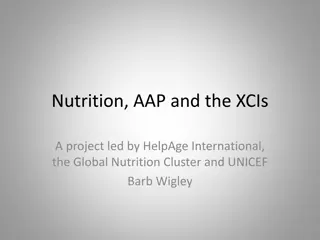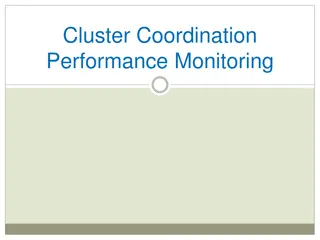Nutrition Cluster Performance Monitoring (CCPM) Review Workshop Preliminary Results 2017
The Nutrition Cluster Performance Monitoring (CCPM) aims to ensure efficient coordination, identify areas for improvement, raise support awareness, and enhance transparency within the cluster. The process involves planning, conducting surveys, analysis, action planning, and monitoring. It does not monitor service delivery or evaluate individual partners. Response rates from different partner types are provided, along with performance scoring criteria. The first CCPM occurred in 2014 and then in 2015, focusing on strengthening partnerships and justifying coordination costs.
Download Presentation

Please find below an Image/Link to download the presentation.
The content on the website is provided AS IS for your information and personal use only. It may not be sold, licensed, or shared on other websites without obtaining consent from the author.If you encounter any issues during the download, it is possible that the publisher has removed the file from their server.
You are allowed to download the files provided on this website for personal or commercial use, subject to the condition that they are used lawfully. All files are the property of their respective owners.
The content on the website is provided AS IS for your information and personal use only. It may not be sold, licensed, or shared on other websites without obtaining consent from the author.
E N D
Presentation Transcript
Nutrition Cluster Performance Monitoring (CCPM) Review Workshop: Preliminary results 2017
Objectives of Nutrition CCPM Objectives of Nutrition CCPM First CCPM took place in March-April 2014 and then in May 2015; Ensure efficient and effective coordination Take stock of what functional areas work well and what areas need improvement Raise awareness of support needed from the HC/HCT, cluster lead agencies, global clusters or cluster partners Opportunity for self-reflection Strengthening transparency and partnership within the cluster Show the added value and justify the costs of coordination
Remember that CCPM Remember that CCPM DOES NOT DOES NOT Monitor response (service delivery by partners) Evaluate individual partners or coordinators Evaluate if/when clusters should be deactivated, merged etc. (Review of the cluster architecture) Exclude usage of other tools with the same purpose
Process of Nutrition CCPM Process of Nutrition CCPM Step 1, Planning: November 2016 Step 2, On-line CCPM Survey: November 2016- January 2017. Preliminary report issued 15 January 2017 and shared with all cluster partners Step 3, Cluster analysis and action planning: CCPM Workshop and development of the Action Plan to improve performance 25 January 2017 Step 4, Follow-up and Monitoring : Finalisation of the Action Plan, presentation to the HCT/Government, implementation of the Action Plan
Nutrition CCPM 2016 Nutrition CCPM 2016- -2017: Response Rates Partner Type Number of responded partners Donors 2 2017: Response Rates Total number of partners Response Rate (%) 5 40.0% International NGOs National Authority National NGOs 27 32 84.4% 0 1 0.0% 10 10 100.0% ICRC/IFRC 0 1 0.0% UN Organizations 2 5 40.0% Total 41 54 76%
Scores and Scores and Colour Colour Coding Coding Score Performance Status > 75% Good 51-75% Satisfactory, needs minor improvement 26-50% Unsatisfactory, needs major improvement 25% Weak
1. Supporting Service Delivery 1. Supporting Service Delivery IASC core functions Indicative characteristics of functions Score 2015 Score 2016-2017 1.1 Provide a platform to ensure that service delivery is driven by the agreed strategic priorities including cross- cutting issues, e.g. gender and GBV 1.2 Develop mechanisms to eliminate duplication of service delivery Established, relevant coordination mechanism recognizing national systems, subnational and co-lead aspects; stakeholders participating regularly and effectively; cluster coordinator active in inter-cluster and related meetings and incorporating feedback on gender equality, empowerment programmes and protection and prevention against GBV. Good Good Cluster partner engagement in dynamic mapping of presence and capacity (4W); information sharing across clusters in line with joint Strategic Objectives. Satisfactory Good
2 2. Informing strategic decision . Informing strategic decision- -making of the HC/HCT for the humanitarian response HC/HCT for the humanitarian response making of the IASC core functions Indicative characteristics of functions Score 2015 Score 2016-17 2.1 Preparing needs assessments and analysis of gaps (across and within Clusters, using information management tools as needed) to inform the setting of priorities, 2.2 Identifying and finding solutions for (emerging) gaps, obstacles, duplication and cross-cutting issues, e.g. GBV. 2.3 Formulating priorities on the basis of analysis and feedback from the community consultation particularly with women and girls Use of assessment tools in accordance with agreed minimum standards, individual assessment/ survey results shared and/or carried out jointly as appropriate. Joint analysis for current and anticipated risks, needs, gaps and constraints; cross cutting issues addressed from outset. Joint analysis supporting response planning and prioritization in short and medium term. Satisfactory Satisfactory Good Satisfactory Satisfactory Good
3. 3. Planning and strategy development Planning and strategy development IASC core functions Indicative characteristics of functions Strategic plan based on identified priorities, shows synergies with other sectors against strategic objectives, addresses cross cutting issues, incorporates exit strategy discussion and is developed jointly with partners. Plan is updated regularly and guides response. Use of existing national standards and guidelines where possible. Standards and guidance are agreed to, adhered to and reported against. Funding requirements determined with partners, allocation under jointly agreed criteria and prioritization, status tracked and information shared. Score 2015 Score 2016-2017 Satisfactory 3.1 Developing sectoral plans, objectives and indicators that directly support realization of the overall response s strategic objectives Satisfactory 3.2 Applying and adhering to common standards and guidelines Good Good 3.3 Clarifying funding requirements, helping to set priorities, and agreeing Cluster contributions to the HC s overall humanitarian funding proposals Satisfactory Good
4. 4. Monitoring and Evaluating Performance Monitoring and Evaluating Performance IASC core functions Indicative characteristics of functions Score 2015 Score 2016-2017 Formats for monitoring and reporting needs agreed upon and used by cluster partners Reports shared by partners on humanitarian needs are taken into account in cluster reports Formats for monitoring and reporting activities agreed upon and used by cluster partners Reports shared by partners on their activities are taken into account in cluster reports 4.1 Monitoring and reporting on activities and needs Good Good Progress reports or bulletins report using agreed indicators for monitoring humanitarian response 4.2 Measuring progress against the Cluster strategy and agreed results Good Cluster bulletins and updates influence partners decisions 4.3 Recommending corrective action where necessary Good Cluster has used information to recommend corrective action
5. 5. Building national capacity in contingency Building national capacity in contingency planning/preparedness. planning/preparedness. IASC core functions Indicative characteristics of functions Score 2015 Score 2016-17 5.1 National contingency plans identified, updated and shared National contingency plans identified and shared Satisfactory Good 5.2 Cluster roles and responsibilities defined and understood Role of the Cluster and partners are clearly defined and understood in the Contingency Plan The Cluster has discussed how to strengthen response capacity in country Satisfactory 5.3 Early warning reports shared with partners Early warning reports shared with partners Satisfactory
6 6. Undertake robust advocacy . Undertake robust advocacy IASC core functions Indicative characteristics of functions Concerns for advocacy identified with partners, including gaps, access, resource needs. Score 2015 Score 2016-17 Satisfactory Satisfactory 4.1 Identify advocacy concerns to contribute to HC and HCT messaging and action 4.2 Undertaking advocacy activities on behalf of cluster participants and the affected population Weak Good Common advocacy campaign agreed and delivered across partners.
Accountability to affected population Accountability to affected population AAP Indicative characteristics of functions Score 2015 Score 2016-17 7.1 Mechanisms to consult and involve affected people in decision-making agreed upon and used by partners Disaster-affected people conduct or actively participate in regular meetings on how to organize and implement the response; agencies have investigated and, as appropriate, acted upon feedback received about the assistance provided. Satisfactory Good 7.2 Mechanisms to receive, investigate and act upon complaints on the assistance received agreed upon and used by partners Good 7.3 Key issues relating to protection from sexual exploitation and abuse have been raised and discussed Satisfactory
Next Steps for the CCPM Next Steps for the CCPM 3. Cluster analysis and action planning In a day meeting, the cluster will discuss and finalise the Cluster Description Report and Coordination Performance Report, and develop an Action Plan to amongst others to address gender and inclusive planning for emergency nutrition programming, addressing empowerment for all, particularly women, girls and marginalized and identify the gaps and risks to response towards GBV (what are potential risks, complaint mechanism, safe-security-confidentiality, legal aid etc.) 4. Follow-up and Monitoring The Cluster will continually review the Final Coordination Performance Report and Action Plan. The Coordination Performance Report and Action Plan will be presented to the HCT and global cluster, to identify support requirements. The cluster will continue to monitor the implementation of its Action Plan at regular intervals. 5. Ideally, the cluster should report to the HCT on the progress every quarter.
